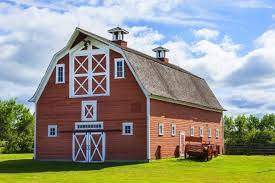Barns, with their iconic and picturesque silhouettes, owe much of their character to the design and structure of their roofs. The barn roof, a fundamental element of agricultural architecture, serves not only as a protective shield against the elements but also as a defining feature that contributes to the overall aesthetic appeal. In this article, we will explore the art and anatomy of barn roofs, delving into the various types, design considerations, and the enduring charm they bring to rural landscapes.
1. The Beauty of Simplicity: Gable Roofs
Gable roofs are the most common and recognizable type found in barns. Characterized by their triangular shape, gable roofs slope downward on two sides, meeting at a central ridge. This simple and effective design allows for efficient rainwater runoff and snow shedding, making it a practical choice for agricultural structures. Gable roofs contribute to the classic and timeless appeal of barns, evoking a sense of rural charm.
2. Gambrel Roofs: A Touch of Elegance and Extra Space
Gambrel roofs, often referred to as barn-style roofs, feature a steeper lower slope and a shallower upper slope. This design not only enhances the barn’s aesthetic with a more dynamic profile but also provides additional storage space in the upper portion of the structure. The gambrel roof design is a perfect marriage of form and function, offering both elegance and practicality.
3. Monitor Roofs: Invoking a Sense of Grandeur
Monitor roofs, also known as raised-center aisle roofs, introduce a raised section running along the length of the ridge. This design allows for increased ventilation and natural light, making it ideal for barns where proper air circulation is crucial. The raised section, often housing a cupola or clerestory windows, adds a touch of grandeur to the barn’s overall silhouette.
4. Saltbox Roofs: Quaint and Distinctive
Saltbox roofs, featuring a long, sloping side and a shorter, steeper side, create a distinctive and quaint appearance. This style is often chosen for its unique asymmetry and historical charm. While less common than gable or gambrel roofs in barn design, the saltbox roof imparts a sense of individuality and character to the structure.
5. Roof Materials: Functionality Meets Aesthetics
The choice of roofing materials plays a crucial role in both the functionality and aesthetics of barn roofs. Common materials include:
Metal Roofing:
- Durable and long-lasting, metal roofing is a popular choice for barns. It provides excellent protection against the elements and is resistant to fire, insects, and rot.
Wood Shingles or Shakes:
- Wooden shingles or shakes contribute to a traditional and rustic look. While less common due to fire concerns, they remain a favorite for those seeking an authentic, historic feel.
Asphalt Shingles:
- Asphalt shingles, known for their affordability and ease of installation, are often chosen for their versatility and variety of available colors.
6. Roof Pitch: Balancing Form and Function
The pitch or slope of a barn roof is a critical design consideration. The pitch affects both the aesthetics and the functionality of the roof. Steeper pitches, common in gable and gambrel roofs, shed snow and rain more effectively, while lower pitches may be chosen for architectural preference or specific functional requirements.
7. Cupolas and Weather Vanes: Ornamental Flourishes
Cupolas, small structures typically positioned on top of barn roofs, serve both functional and ornamental purposes. They provide ventilation, improving air circulation within the barn, and often house weather vanes. Weather vanes, often shaped like roosters or other animals, add a charming and nostalgic touch to the barn’s exterior.
8. Maintenance and Longevity: Preserving the Heritage
Proper maintenance is crucial for preserving the integrity and longevity of barn roofs. Regular inspections, prompt repairs, and coatings to protect against rust and decay are essential practices. Attention to the condition of roofing materials ensures that the barn continues to stand as a testament to rural heritage.
Conclusion: The Crowning Glory of Rural Architecture
Barn roofs, with their diverse designs and functional considerations, stand as the crowning glory of rural architecture. From the classic simplicity of gable roofs to the elegance of gambrel designs, these structures not only protect the agricultural assets within but also contribute to the cultural and visual tapestry of rural landscapes. The art and anatomy of barn roofs tell a story of craftsmanship, functionality, and enduring charm that continues to captivate those who appreciate the beauty of rural architecture.

